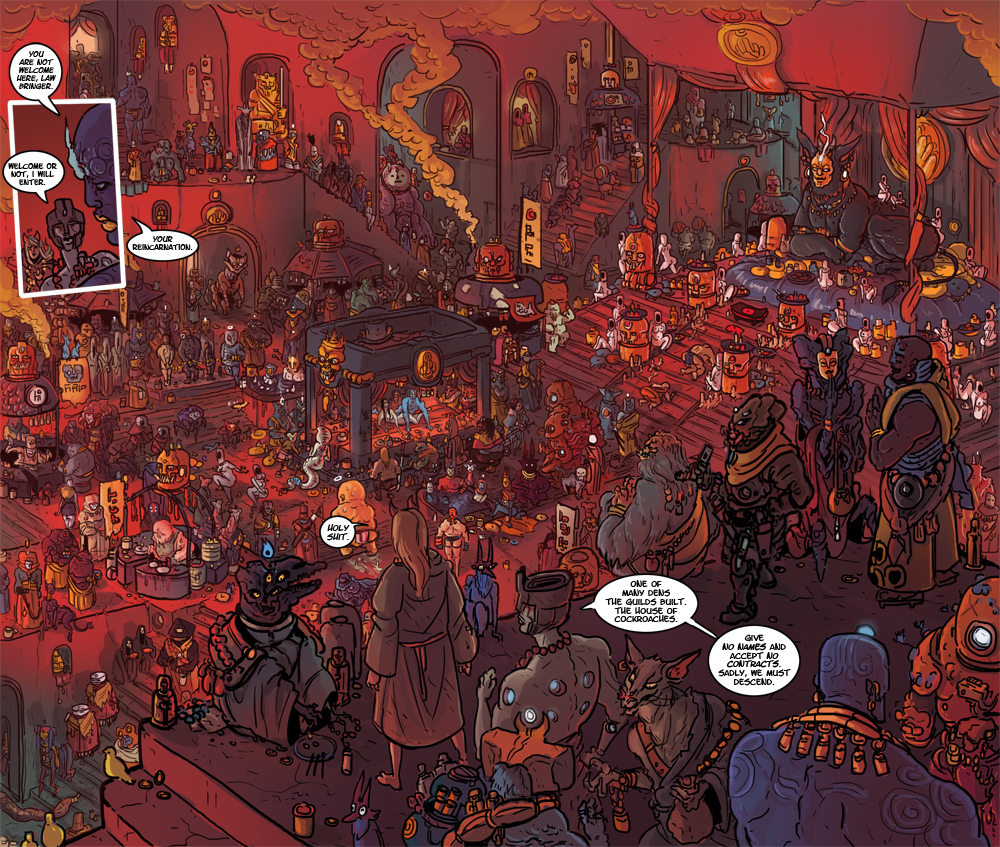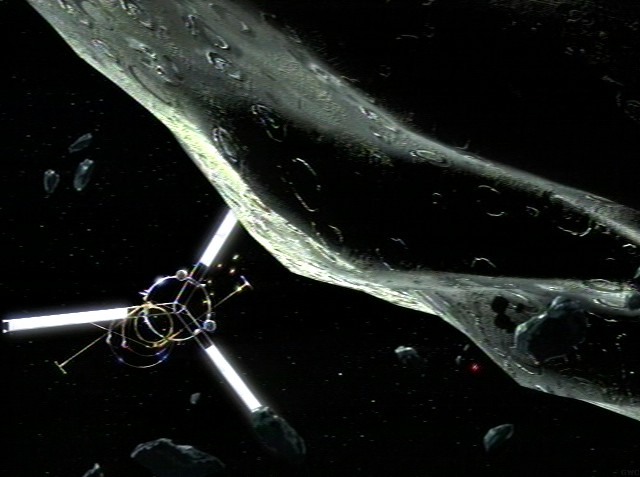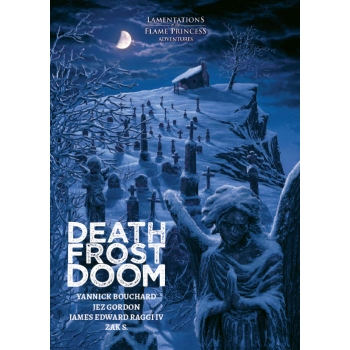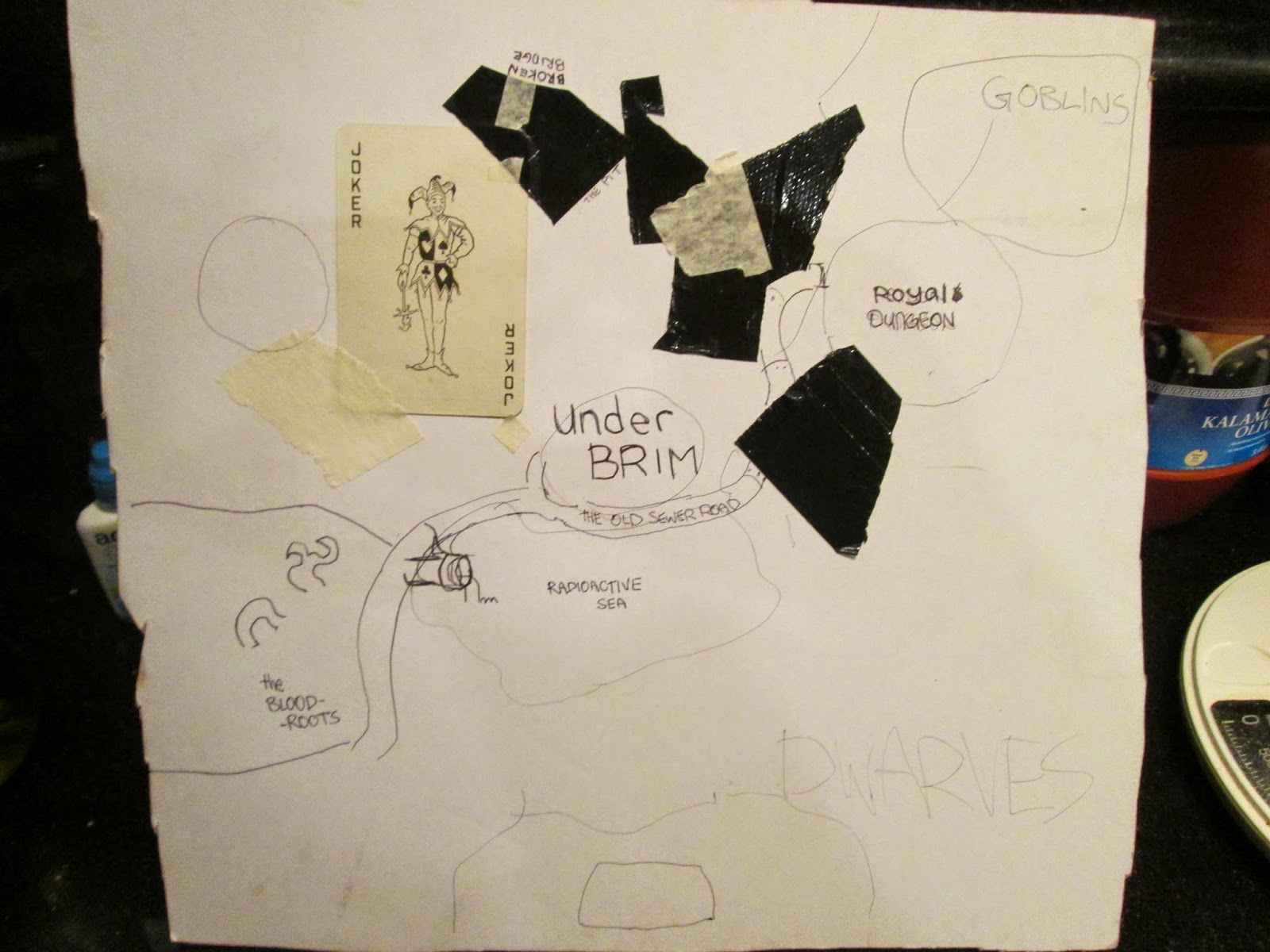If you play in my games, don't read this.
Well, my old post about
The Negadungeon blew up for no reason this weekend. There's
praise,
criticism and
some charming folks who came to appreciate the concept even though they'd never run one. People are talking about the post in polish and german. Who knows what they're saying? Not google translate, that's for sure. The concept has grown bigger than me, and ancient. I see people who assume they've missed the long history of the term, and speak like it crawled out of the primordial soup in the 80's as a leech on D&D's back.
A few people seem to read the thing as a glowing review of James Raggi's LOTFP adventures. That's not quite accurate: This is what I believe these adventures aspire to, the reason why James Raggi does things like curse the PC's as soon as they look at the dungeon. It's an ideal, not a documentary, in the same way that the
Old School Primer isn't a literal description of how people played in the 80's. The adventures themselves often fall short of the mark for me.
The most obvious problem with the concept: the DM prepares a Negadungeon, and the players sensibly take one look at the thing and decide to run for the hills. As in
this review of Death Frost Doom, where the DM forces an unwilling set of players to complete the module, or
this session report where the players flee Tower of the Stargazer and the DM has to improv the rest of the session.
The interesting thing is that I haven't heard this complaint of horror modules for Call of Cthulhu et. al. Any sensible PC would take one look at any horror adventure, call the police, and fly out of the country. They don't do it because they know what they're here for. The DM has made a horrorshow, they've made PC's for it, everybody's gathered around the table with the understanding that the PC's will fling themselves into the terrible situation at hand like the characters in a horror movie.
I think this is the greatest problem with Negadungeons, but also the greatest source of potential. The obvious thing to do in making this killer dungeon would be to force the players to do it, right? Lock the door behind them, or put it on the table and say "We're running Death Frost Doom tonight, everybody get ready to die." - the approach that makes Call of Cthulhu work. But the approach Raggi takes - where the players have to actively seek out the place, often in the middle of a campaign, and push past the people trying to stop them - has the potential to make the players responsible for their own doom. They weren't forced into it.
I'll give an example. Spoilers for
Spec Ops: The Line.
The Line is a video game that pretends to be a Call-of-Duty power fantasy. It's a trap. As the game goes on, it slowly turns into a Negadungeon. The turning point is a scene half-way where the player commits an atrocity. After that, you start dying, going insane, flying down the slippery slope to the point where you find out it was all for nothing. The player is meant to feel horrified and guilty for all this. Loading screen tips start saying "This is all your fault."
The problem with this guilt-trip is that it isn't the players fault: If you want to play the game, you need to commit the atrocity. (The game's writers claim your choice here is to turn off the game and walk away: this is the good ending.) This is analogous to playing a horror module: You force yourself to make the bad decision because you've paid for this game/your DM has paid for this module. You're making a meta-game decision that leaves you immune to shame and horror. Of course this isn't your fault: You just wanted to play the game you paid for.
The potential with allowing the players to walk away is that it
is their fault if they commit the atrocity. Having a genuine choice means the PC's can feel genuine guilt, knowing that they were sent down this spiral because of their own greed and doomed obsessions - not because you wrote "You have a doomed obsession" on their character sheet. You haven't shot them in the head: You've just given them the gun and allowed them to shoot themselves.
Of course, pulling that off is going to be difficult. In practice, Death Frost Doom relies on a cheap trick to get the players to orchestrate their own doom. It should be their greed that bought them down here - but it's more likely that they just felt like they had to play the adventure their DM prepped. They'll fall for the trick either way, and they probably won't feel like it was their fault.
If I made a Negadungeon, I would make the one discussed in
this thread. The trick: it's a normal dungeon that can
become a Negadungeon if the players make the wrong choices. If they don't take the bait, you still have a fun adventure to run through for the evening. Because you have that fallback, the players don't feel forced to make decisions for meta-game reasons, and you haven't wasted your time prepping a dungeon they'll never play.
The Finder haunts/ These twisting hallways/ His sightless eyes/ Can see you always
I've realized not everyone can read the thread I linked. Here it is.
I have sketched a Demon Horse Tower. Now I am looking for stuff to put inside to post it on my blog.

I want to write up rooms and monsters for it. You only have to make eye contact once to realize how fucked up horses are.

I would fill it with stuff inspired by Pathologic.
http://www.rockpapershotgun.com/2008/04/12/butchering-pathologic-part-3-the-soul/Animals were sacred here, once. Now the tower's grown fat off a slaughterhouse that churns around the clock. This constant stream of sacrifices has twisted the old gods into something strange and powerful that lies at the center of the slaughterhouse, bleeding and screaming.

I would fill it with horses.
Slaughterhouse architecture: gently curving hallways, so the cows in the back can't see what's in front.
Railings that keep a gentle pressure on the side of the animals, so they remain calm. Soothed.
Good drainage in every room.
Stairs for the animals to walk up, so they enter the process at the top of the building. After their deaths, their body weight makes it easier for the meat to slide down/onwards.
You wouldn't even need to make the dungeon a slaughterhouse. Just use the slaughterhouse as a unifying theme. Put drains and rails and chains in every room, and eventually players will realize exactly what they are going to find at the bottom.

I am taking notes, I will post some rooms soon.

+Arnold K. I agree that you don't want to go crazy with pig guts on all the walls and the like. Use the slaughterhouse stuff as a subtle omen, like the movie Chinatown.
Maybe people call the place The Slaughterhouse or Meat City - then you go there, and there's no meat, no reference to it. As you go up the tower all this stuff creeps in around the edges. People start making vague references to it, places are only described as "The Brain", "The Heart".
Also have an NPC who says "This world is a Machine. A Machine for Pigs. Fit only for the slaughtering of Pigs."

+Jack Mack You just referenced, like, two of my favorite things, and one thing that I intend to play.
NPCs should just refer to it as The Machine.
The bottom floor needs to be meat, though. Like Death Frost Doom, except the final act needs to be fountains of gore and swinging meat hooks, etc. And purple worms rising from the vats of ground beef.
Can you imagine being trapped in a small room with some pigs, and then the doors open and the pigs are running from ambulatory pig grinder machines? You better run, too.
Maybe the trick to the dungeon is figuring out how to avoid turning it on. Like, if you can get through the whole thing without activating it, it's pretty mild. But once the Machine is on, every room becomes a death trap. Every floor drain begins vomiting up blood and indian burial grounds.
And the further down you are when the machine activates, the more fucked you are, because you need to go all the way back out. Unless you think you can make it out of the Meat Exit at the bottom.

+Arnold K. yes, yesss.
I like the Death Frost Doom "no-one's getting out of here unscarred" thing, but you definitely need the doom be triggered by the player's decisions, and the central DFD trick is a little cheap.
I guess the whole place is ruined, and the more you turn on the machine the more you summon the old ghosts and bring back the gory days. The bottom floor has a few settings, from easy to horrific. Pulling levers on the way down opens up the place and disgorges ultra-valuable parts from long-extinct animals, but makes the meat god at the bottom worse and worse.
Maybe if you get too greedy, at the highest setting when the machine is coming fully to life with apocalyptic consequences, all those valuable animal bits start coming alive in your packs and joining together.

























